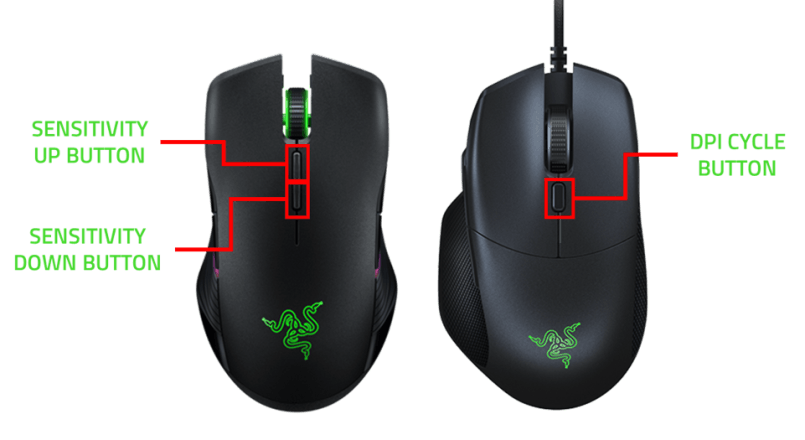Do you ever find yourself wondering about the accuracy and responsiveness of your Razer mouse? Whether you’re a gamer looking to fine-tune your settings for optimal performance or a graphic designer seeking precise control, understanding the DPI (dots per inch) of your mouse is crucial. DPI determines how sensitive your mouse is to movements, and being able to check and adjust it to your liking can greatly enhance your overall experience. In this guide, we will delve into the step-by-step process of checking the DPI on your Razer mouse, equipping you with the knowledge to unlock its full potential.
As a Razer user, you already know that their products are renowned for their cutting-edge technology and exceptional performance. However, with the diverse range of Razer mice available, each offering various DPI settings, it can be challenging to determine the exact DPI of your device. Fear not, though, as we’re here to demystify the process and simplify it for you. By the end of this article, you will have the confidence to check your Razer mouse’s DPI and tailor it to suit your specific needs, whether you’re seeking lightning-fast cursor movements or pixel-perfect precision. So, let’s dive in and discover how to unlock the full potential of your Razer mouse by checking its DPI.
How to Check DPI on Razer Mouse:
- Connect your Razer mouse to your computer.
- Open the Razer Synapse software.
- Click on the mouse icon at the top of the window.
- Select your mouse from the list of connected devices.
- In the mouse settings, you will find the DPI slider. Slide it to adjust the DPI.
- To check the current DPI, move the slider and observe the changes in the sensitivity.

How to Check DPI on Razer Mouse
In this article, we will guide you through the process of checking the DPI (dots per inch) on your Razer mouse. DPI is an important setting that determines the sensitivity of your mouse cursor movement. By knowing your mouse’s DPI, you can customize your mouse settings for a more precise and comfortable experience. Follow the step-by-step instructions below to find out how to check the DPI on your Razer mouse.
Step 1: Open Razer Synapse Software
The first step is to open the Razer Synapse software, which is the official configuration utility for Razer mice. If you don’t have it installed on your computer, you can download it from the official Razer website. Once installed, launch the software by double-clicking on the Razer Synapse icon on your desktop or searching for it in the Start menu.
Step 2: Connect Your Razer Mouse
Make sure your Razer mouse is connected to your computer via USB or wireless connection. The Razer Synapse software should automatically detect your mouse and display it in the main window. If your mouse is not recognized, try disconnecting and reconnecting it or restarting your computer.
Step 3: Access Mouse Settings
Once your mouse is detected, click on the “Devices” tab in the Razer Synapse software. This will bring up a list of connected devices, including your Razer mouse. Click on your mouse to access its settings.
Step 4: Check DPI Settings
In the mouse settings window, navigate to the “Performance” tab. Here, you will find various options related to your mouse’s performance, including the DPI settings. Look for a section labeled “DPI” or “Sensitivity” and click on it to expand the options.
Step 5: View and Adjust DPI
Within the DPI settings section, you will see a slider or a drop-down menu that displays the current DPI value. This is the DPI setting that your mouse is currently using. You can slide the slider or select a different value from the drop-down menu to adjust the DPI to your preference. As you change the DPI, you may also see a description of how the sensitivity will be affected.
Step 6: Test the DPI
After adjusting the DPI, it’s a good idea to test the new sensitivity to see if it feels comfortable for you. Open a document or a web page and move your mouse around to get a sense of how the cursor responds. If it feels too slow or too fast, you can go back to the mouse settings in Razer Synapse and readjust the DPI until you find the optimal setting for your needs.
Step 7: Save Settings
Once you are satisfied with your DPI settings, make sure to click on the “Apply” or “Save” button in the Razer Synapse software to save the changes. This will ensure that your new DPI setting is applied every time you use your Razer mouse.
Step 8: Customize Additional Settings (Optional)
In addition to DPI settings, Razer Synapse offers many other customization options for your mouse. You can explore the software further to adjust things like button assignments, lighting effects, and advanced settings. Feel free to experiment with these features to personalize your Razer mouse even further.
Step 9: Repeat for Multiple Profiles (If Applicable)
If you have multiple profiles set up for different purposes, such as gaming and productivity, make sure to repeat the above steps for each profile. This way, you can have different DPI settings for each profile and easily switch between them using the Razer Synapse software.
Step 10: Enjoy Your Optimized Mouse Experience
With your DPI properly checked and adjusted, you can now enjoy a more precise and comfortable mouse experience. Whether you’re using your Razer mouse for work, gaming, or any other tasks, having the correct DPI setting can greatly enhance your overall performance. Remember, you can always revisit the Razer Synapse software to fine-tune your mouse settings whenever needed.
Frequently Asked Questions
Welcome to our FAQ section where we address some common questions about checking DPI on a Razer mouse. Here, you will find step-by-step instructions and useful information to help you understand DPI and how to check it on your Razer mouse.
Question 1: How do I check the DPI on my Razer mouse?
To check the DPI on your Razer mouse, follow these steps:
1. Open the Razer Synapse software on your computer.
2. Click on the mouse icon in the dashboard.
3. Select the mouse you want to check the DPI for.
4. In the mouse settings, navigate to the “Sensitivity” tab.
5. The DPI value will be displayed in the “DPI” section.
6. You can also adjust the DPI settings according to your preference from this tab.
Question 2: Can I check the DPI of my Razer mouse without using the Razer Synapse software?
Yes, you can check the DPI of your Razer mouse without using the Razer Synapse software. However, it may vary depending on the specific model of your mouse. Here’s how you can check it:
1. Look for a dedicated DPI button on your Razer mouse. It is usually located near the scroll wheel.
2. Press the DPI button. The DPI value will be indicated by the LED lights on your mouse. Each LED color represents a different DPI level.
3. Check your mouse’s user manual or visit the Razer website for more information on specific DPI values corresponding to LED colors for your mouse model.
Please note that this method may not be applicable to all Razer mouse models, as some may require the Razer Synapse software for DPI adjustment and monitoring.
Question 3: What is DPI and why is it important for gaming?
DPI stands for Dots Per Inch and is a measure of sensitivity for a computer mouse. It refers to how many pixels on the screen the mouse pointer moves when the mouse is moved one inch. In gaming, DPI is crucial as it determines the speed and precision of cursor movement.
Higher DPI settings allow for faster cursor movement, allowing gamers to quickly aim or turn around in games. On the other hand, lower DPI settings provide more precision, allowing for accurate targeting. Having the ability to adjust DPI according to personal preference and gaming needs is essential for gamers to optimize their performance.
Question 4: Can I change the DPI settings on my Razer mouse?
Yes, you can change the DPI settings on your Razer mouse using the Razer Synapse software. Here’s how:
1. Open the Razer Synapse software on your computer.
2. Click on the mouse icon in the dashboard.
3. Select the mouse you want to change the DPI settings for.
4. In the mouse settings, navigate to the “Sensitivity” tab.
5. Adjust the DPI sliders according to your preference.
6. You can also create different DPI profiles and assign them to specific games or applications.
Remember to apply the changes for them to take effect on your Razer mouse.
Question 5: How can I determine the best DPI setting for my gaming needs?
The best DPI setting for gaming depends on various factors such as personal preference, gaming genre, and screen resolution. Here are some general tips to help you determine the best DPI setting:
1. Experiment with different DPI settings: Start with a moderate DPI setting and gradually increase or decrease it to find your comfort zone.
2. Consider your gaming style: If you play fast-paced action games, a higher DPI might be more suitable, while slower-paced games may require lower DPI for precision.
3. Take your screen resolution into account: Higher screen resolutions may require higher DPI settings to cover more screen space with mouse movement.
4. Practice and adapt: Give yourself time to adapt to a new DPI setting and practice with it to see if it enhances your gaming performance.
Remember, the best DPI setting is subjective and varies from person to person. Find what works best for you and enjoy a comfortable and responsive gaming experience.
How to Change DPI on a Razer Mouse (EASY TUTORIAL)
In conclusion, understanding how to check the DPI on your Razer mouse is essential for gamers and professionals alike. By knowing and adjusting the DPI settings, you can fine-tune the sensitivity of your mouse to suit your specific needs and preferences. Whether you’re looking for precision in gaming or smooth cursor movements in design work, being able to easily check and change the DPI on your Razer mouse empowers you to optimize your performance.
To check the DPI on your Razer mouse, simply follow the steps mentioned earlier in this article. Remember to consider your specific requirements and experiment with different DPI settings to find the perfect balance between speed and accuracy. With this knowledge, you’ll be able to take your gaming or professional productivity to new heights, maximizing your potential and achieving superior results. So, go ahead, take control of your Razer mouse’s DPI settings, and elevate your performance to the next level.

